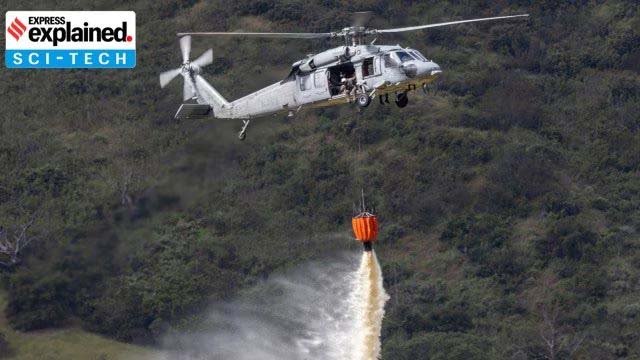UTTARAKHAND FOREST FIRES
Amid forest fires in Uttarakhand’s Nainital district, the Indian Air Force was engaged in firefighting operations on Sunday (April 28), the second day the fires continued raging.
WHAT HAS CAUSED THESE FOREST FIRES?
While
the exact cause of these fires is unknown so far, there are multiple causes of forest fires & multiple factors which increases its intensity.
CAUSES OF FOREST FIRES
Most fires are believed to be man-made, due to changes in agriculture and unchecked land-use patterns.
The forest department has previously cited
four causes of wildfires in Uttarakhand –

- Deliberate fires by locals,
- Carelessness,
- Farming-Related activities and
- Natural Reasons.
According to a government report, locals set forests on fire for the growth of good quality grass, to cover up illegal cutting of trees, for poaching, etc.
HOW FREQUENT ARE FOREST FIRES IN INDIA?
- The forest fire season in India lasts between November to June.
- Higher fire incidents are reported in March, April and May due to ample availability of dry biomass following the end of winter and amid the prevailing summer season.
- Factors like temperatures, precipitation, vegetation, and moisture contribute to the scale and frequency of these fires.
- According to experts, three factors cause the spread of forest fires —
- Fuel load (Dry leaves are fuel for forest fires)
- Oxygen and
- Temperature.
The Forest Survey of India (FSI) website states that nearly
36 per cent of India’s forests are prone to frequent fires.
WHICH TYPE OF FOREST IS MORE PRONE TO FOREST FIRES?
The FSI website adds: “
Severe fires occur in many forest types particularly
dry deciduous forest, while
evergreen, semi-evergreen and montane temperate forests are comparatively less prone (India State of Forest Report 2015).
Nearly
4% of the country’s forest cover is extremely prone to fire, whereas
6% of forest cover is found to be very highly fire prone (ISFR 2019).”
REGIONS PRONE TO FOREST FIRES:
An FSI analysis in ISFR
2021 also found that
states in northeastern India showed the
highest tendency for forest fires. Parts of western
Maharashtra, southern Chhattisgarh, central Odisha and regions in Andhra Pradesh,
Telangana and Karnataka also showed patches of
extremely and very highly fire-prone zones.
TYPES OF FOREST FIRE LINES
According to the
National Disaster Management Authority (NDMA) website, two types of fire lines are in practice –
- Kachha or covered fire lines: In Kaccha fire lines, the undergrowth and shrubs are removed while trees are retained to decrease the fuel load.
- Pucca or open fire lines: The Pucca fire lines are clear felled areas separating a forest/compartment/block from another to control the spread of potential fires.
METHODS TO PREVENT FOREST FIRES
The Ministry of Environment, Forest and Climate Change (MoEFCC) lists the following
methods to prevent and control a forest fire:
- Construction of watch towers for early detection;
- Deployment of fire watchers;
- Involvement of local communities, and
- The creation and maintenance of fire lines.
Satellite based
remote sensing technology and GIS tools have been effective in better prevention and management of fires through creation of
early warning for fire prone areas, monitoring fires on real time basis and estimation of burnt scars.
WHAT ARE WE DOING NOW?
Indian Air Force’s MI 17 V5 helicopter was deployed on Saturday (April 27) to extinguish the raging forest fires in Nainital district, Uttarakhand, according to the state’s Chief Minister Pushkar Singh Dhami.

The helicopter used a
“Bambi Bucket”, also known as a helicopter bucket or a
heli bucket, to collect water from Bhimtal lake, located near Nainital, and poured it over the burning forests.
Note: Connect with Vajirao & Reddy Institute to keep yourself updated with latest UPSC Current Affairs in English.
Note: We upload Current Affairs Except Sunday.